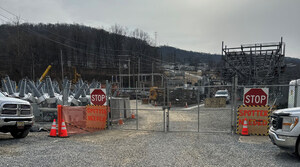FirstEnergy Projects Support Western Pennsylvania Shale Gas Boom
Transmission Upgrades Support Rising Electric Use and Economic Expansion in West Penn Power Territory
GREENSBURG, Pa., Feb. 9, 2015 /PRNewswire/ -- FirstEnergy Corp. (NYSE: FE) is investing nearly $35 million in new electric transmission projects to support the Marcellus Shale gas industry in western Pennsylvania. The new transmission facilities also will help enhance service reliability for West Penn Power customers.
The projects include upgrading an existing transmission line as well as building or expanding two electric substations to accommodate expanding natural gas processing plants and compressor stations in western Pennsylvania's Marcellus Shale gas fields. New gas facilities in the area account for about 370 megawatts (MW) of projected load growth, or the equivalent of more than 180,000 new homes in FirstEnergy's western Pennsylvania utility territory.
"Our investment in new transmission facilities directly supports the fast-growing Marcellus Shale industry," said Carl Bridenbaugh, vice president, Transmission at FirstEnergy. "This industry continues to generate jobs and economic prosperity across western Pennsylvania, and we are working quickly to upgrade our system to continue providing our customers access to safe, reliable and affordable electric power."
PJM Interconnection, the regional grid operator, has directed FirstEnergy to build these projects to maintain electric reliability in the region. The projects include a $31 million substation in Washington County to support a new midstream gas processing facility near Burgettstown, Pa., that separates natural gas into dry and liquid components. The refinement and separation processes require large amounts of electricity. The new substation also will reinforce the regional transmission system which is expected to benefit more than 40,000 West Penn Power customers in Washington and Allegheny counties. The new substation is scheduled to be completed and operational in 2016.
FirstEnergy also plans to install new equipment to increase and maintain voltage levels in an existing transmission substation near Houston, Pa. The substation improvements will support operations at a local gas processing plant. The $1 million upgrade, expected to be completed and operational in 2015, also will reinforce the regional transmission system and is expected to benefit more than 23,000 customers in Washington County.
The company also will upgrade a nine-mile, 138-kilovolt transmission line connecting a high-voltage substation near Weirton, W. Va., to a high-voltage substation near Burgettstown, Pa. The $2.3 million project involves replacing several existing wood pole structures with taller structures, or modifying those existing structures to increase their height. This will increase line clearances and allow the line to carry more electricity to support area gas compressor stations and enhance service reliability for nearly 12,000 customers in Washington County.
This work is part of a $250 million investment in regulated transmission projects in 2015 across FirstEnergy. These projects will support approximately 1,100 megawatts of expected electric load growth through 2019. FirstEnergy is currently evaluating additional transmission upgrades as new service requests from shale gas developers continue throughout the region.
West Penn Power serves about 720,000 customers in 24 Pennsylvania counties. Visit FirstEnergy on the web at www.firstenergycorp.com and connect with West Penn Power on Twitter @W_Penn_Power and on Facebook at www.facebook.com/WestPennPower.
FirstEnergy is a diversified energy company dedicated to safety, reliability and operational excellence. Its 10 electric distribution companies form one of the nation's largest investor-owned electric systems, serving customers in Ohio, Pennsylvania, New Jersey, West Virginia, Maryland and New York.
Forward-Looking Statements: This news release includes forward-looking statements based on information currently available to management. Such statements are subject to certain risks and uncertainties. These statements include declarations regarding management's intents, beliefs and current expectations. These statements typically contain, but are not limited to, the terms "anticipate," "potential," "expect," "forecast," "will," "intend," "believe," "estimate" and similar words. Forward-looking statements involve estimates, assumptions, known and unknown risks, uncertainties and other factors that may cause actual results, performance or achievements to be materially different from any future results, performance or achievements expressed or implied by such forward-looking statements, which may include the following: the speed and nature of increased competition in the electric utility industry, in general, and the retail sales market in particular; the ability to experience growth in the Regulated Distribution and Regulated Transmission segments and to successfully implement our revised sales strategy in the Competitive Energy Services segment; the accomplishment of our regulatory and operational goals in connection with our transmission plan and pending distribution rate cases and the effectiveness of our repositioning strategy; the impact of the regulatory process on pending matters in the various states in which we do business including, but not limited to, matters related to rates and pending rate cases, and the Electric Security Plan IV in Ohio; the impact of the federal regulatory process on the Federal Energy Regulatory Commission (FERC) regulated entities and transactions, in particular FERC regulation of wholesale energy and capacity markets, including the PJM markets and also FERC-jurisdictional wholesale transactions, FERC regulation of cost-of-service rates, including FERC Opinion No. 531's revised Return on Equity methodology for FERC-jurisdictional wholesale generation and transmission utility service and FERC's compliance and enforcement activity, including compliance and enforcement activity related to NERC's mandatory reliability standards; the uncertainties of various cost recovery and cost allocation issues resulting from American Transmission Systems, Incorporated's realignment into PJM Interconnection, L.L.C.; economic or weather conditions affecting future sales and margins such as a polar vortex or other significant weather events, and all associated regulatory events or actions; regulatory outcomes associated with storm restoration costs, including but not limited to, Hurricane Sandy, Hurricane Irene and the October snowstorm of 2011; changing energy, capacity and commodity market prices including, but not limited to, coal, natural gas and oil, and their availability and impact on margins; the continued ability of our regulated utilities to recover their costs; costs being higher than anticipated and the success of our policies to control costs and to mitigate low energy, capacity and market prices; other legislative and regulatory changes, and revised environmental requirements, including, but not limited to, possible greenhouse gases emission, water discharge, and coal combustion residuals regulations, the potential impacts of Cross-State Air Pollution Rule, and the effects of the United States Environmental Protection Agency's Mercury and Air Toxics Standards rules including our estimated costs of compliance; the uncertainty of the timing and amounts of the capital expenditures that may arise in connection with any litigation, including New Source Review litigation, or potential regulatory initiatives or rulemakings (including that such expenditures could result in our decision to deactivate or idle certain generating units); the uncertainties associated with the deactivation of certain older regulated and competitive fossil units, including the impact on vendor commitments, and the timing thereof as they relate to, among other things, Reliability Must Run arrangements and the reliability of the transmission grid; the impact of other future changes to the operational status or availability of our generating units; adverse regulatory or legal decisions and outcomes with respect to our nuclear operations (including, but not limited to the revocation or non-renewal of necessary licenses, approvals or operating permits by the Nuclear Regulatory Commission or as a result of the incident at Japan's Fukushima Daiichi Nuclear Plant); issues arising from the indications of cracking in the shield building at Davis-Besse; the risks and uncertainties associated with litigation, arbitration, mediation and like proceedings, including, but not limited to, any such proceedings related to vendor commitments; replacement power costs being higher than anticipated or not fully hedged; the ability to comply with applicable state and federal reliability standards and energy efficiency and peak demand reduction mandates; changes in customers' demand for power, including, but not limited to, changes resulting from the implementation of state and federal energy efficiency and peak demand reduction mandates; the ability to accomplish or realize anticipated benefits from strategic and financial goals, including, but not limited to, the ability to continue to reduce costs and successfully execute our announced financial plans designed to improve our credit metrics and strengthen our balance sheet through, among other actions, our previously-implemented dividend reduction and our other proposed capital raising initiatives; our ability to improve electric commodity margins and the impact of, among other factors, the increased cost of fuel and fuel transportation on such margins; changing market conditions that could affect the measurement of certain liabilities and the value of assets held in our Nuclear Decommissioning Trusts, pension trusts and other trust funds, and cause us and/or our subsidiaries to make additional contributions sooner, or in amounts that are larger than currently anticipated; the impact of changes to material accounting policies; the ability to access the public securities and other capital and credit markets in accordance with our announced financial plans, the cost of such capital and overall condition of the capital and credit markets affecting us and our subsidiaries; actions that may be taken by credit rating agencies that could negatively affect us and/or our subsidiaries' access to financing, increase the costs thereof, and increase requirements to post additional collateral to support outstanding commodity positions, letters of credit and other financial guarantees; changes in national and regional economic conditions affecting us, our subsidiaries and/or our major industrial and commercial customers and other counterparties with which we do business, including fuel suppliers; the impact of any changes in tax laws or regulations or adverse tax audit results or rulings; issues concerning the stability of domestic and foreign financial institutions and counterparties with which we do business; and the risks and other factors discussed from time to time in our United States Securities and Exchange Commission filings, and other similar factors. The foregoing review of factors should not be construed as exhaustive. New factors emerge from time to time, and it is not possible for management to predict all such factors, nor assess the impact of any such factor on FirstEnergy's business or the extent to which any factor, or combination of factors, may cause results to differ materially from those contained in any forward-looking statements. FirstEnergy expressly disclaims any current intention to update, except as required by law, any forward-looking statements contained herein as a result of new information, future events or otherwise.
SOURCE FirstEnergy Corp.
Related Links
WANT YOUR COMPANY'S NEWS FEATURED ON PRNEWSWIRE.COM?
Newsrooms &
Influencers
Digital Media
Outlets
Journalists
Opted In





Share this article